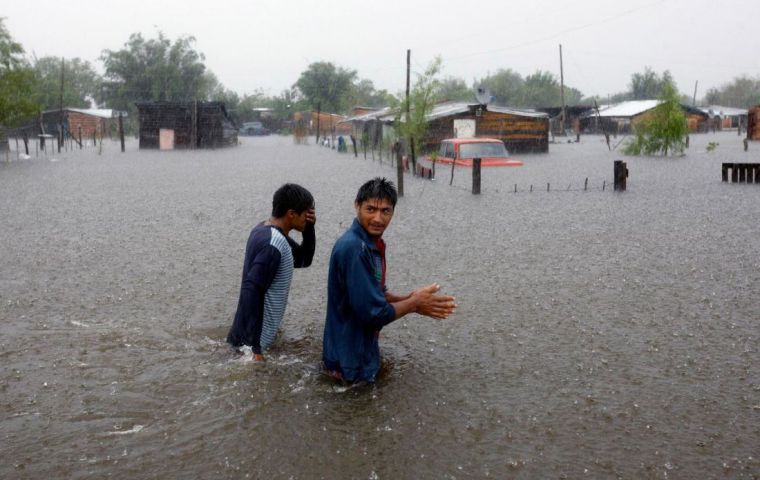MercoPress. South Atlantic News Agency
Extreme wet January displaces thousands and floods farmland in Mercosur member countries
 The flooded region, which extends into Paraguay, Uruguay and Brazil, has received about five times more rain than expected since the beginning of the year
The flooded region, which extends into Paraguay, Uruguay and Brazil, has received about five times more rain than expected since the beginning of the year Intense rainfall in northeast Argentina and neighbouring areas in Mercosur members has caused devastating floods, amplifying the economic burdens of Argentina's recession. Over 5,000 people have evacuated the region, and millions of hectares of crops have been sent underwater.
The flooded region, which extends into Paraguay, Uruguay and Brazil, has received about five times more rain than expected since the beginning of the year. Some areas received a whole year’s worth of rainfall in the first 15 days of the calendar year.
Damages to farmland ring in around US$2 billion, according Coninagro, an Intercooperative Agricultural Confederation based in Buenos Aires. The group reported that 2.4 million hectares of soybeans are flooded. The greatest losses come from the Pampa Húmeda region, one of the main food producers in the world. Other crops like corn and cotton, along with livestock have suffered across the Northeast.
In Uruguay some 1.500 people have been evacuated to temporary housing because of flooding and much of the highways network has been seriously damaged with some bridges washed away. Rains have hit wheat harvesting, soybean and rice plantations. Overflowed hydroelectric dams have been forced to ease water further aggravating the situation. However for cattle breeding in Uruguay, pastures are abundant.
Just last year, Argentina was plagued with severe drought, the worst that had hit the country in half a century. This drought crushed the country’s agricultural sector and strained the country’s economy. It’s blamed in part for the current run on Argentine currency.
Qué impotencia y angustia da ver el campo en esa situación. Pobres peones, animales, todo. Da pena ver todo ese trabajo destruido.#Video de las inundaciones en #Argentina. pic.twitter.com/77WUaEtu6U
— Manuel Serra (@serra_sur) 18 de enero de 2019
Heavy rains can waterlog growing crops or interfere with key sowing and re-seeding processes, Coningrado said. And in provinces like Corrientes, where water has reached in some places nearly two meters deep, herds of cattle and other livestock can be displaced.
If the rain keeps coming, farmland will continue to be aggravated since there is a limit to what the soil can absorb. Forecast models show that rain will continue in the affected areas over the next two weeks. Soils should begin to dry by mid-February, an analyst from Refinitiv Agriculture.
Any further rain could have serious economic implications, Julio Calzada, chief economist of the Rosario Cereal Exchange said. “The harvest will depend on the climate and the economy will depend to a great extent on the harvest,” Calzada said. “The concern is that the volatility of the climate could continue until the end of January”.





Top Comments
Disclaimer & comment rules-

Read all commentsNever rains but it pours in Argentina
Jan 21st, 2019 - 11:39 am 0Commenting for this story is now closed.
If you have a Facebook account, become a fan and comment on our Facebook Page!